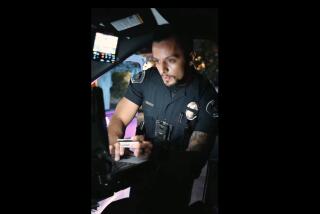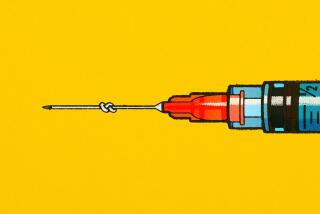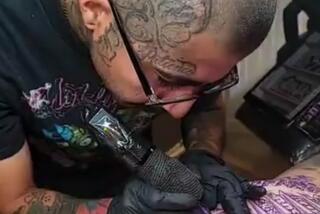Tattoos Gaining Respect as Safe-and-Sane Personal Statements : Culture: Needlepoint on human skin is no longer just for tough guys. Lots of middle-class young adults now wear their hearts under their sleeves.
NEW YORK — They lie beneath threads of respectability, under crisp Brooks Brothers suits and trendy Donna Karan dresses.
Call them declarations of individuality or a permanent needlepoint counterpoint to conformity. Tattoos are no longer just a mark of rebellion among bikers, criminal types and sailors. They have infiltrated corporate settings.
“Typpies,” as tattooed young professionals are called, don’t go in for the colorful, whimsical depictions of tigers, dragons, unicorns and other images of late-1960s poster art. They’re big on ethnic themes: Maori armbands, Celtic symbols and Egyptian fertility signs.
Tattoos are especially popular with people in the arts, but they’re getting under the skin of those in the mainstream as well.
Nurses, doctors, stockbrokers and corporate writers are rolling up their sleeves, lowering their pants or otherwise baring flesh to injections of ink about 1/16 of an inch below the skin’s surface.
Television is full of inked skin. Bart Simpson got a tattoo. He wanted it to say “Mother,” but Marge discovered him and yanked him away with only “moth” inscribed. Ellyn on “thirtysomething” has a yellow rose on her derriere. And almost everyone knows about Roseanne Barr’s having had a declaration of love for her real-life husband branded on her posterior.
Cher graced the cover of November’s Vanity Fair showing her latest tattoo, a snaking silver chain with three dangling ornaments at the top of her left arm. At the Red Devil Studios in Los Angeles, her favorite tattoo spot, the clients are “lots of people in professional jobs that you wouldn’t know have tattoos,” said the studio’s owner, Jill Jordan. (Tattoo artists prefer studio to parlor , which they feel carries more tawdry connotations.)
Most of Jordan’s clients get their tattoos on upper arms or other spots seldom seen around the office, she said.
“They don’t feel a need to show it off,” Jordan said. “I’ve done many actors and actresses, lawyers, a dentist and then his dental hygienist--who came in after her boss got his. You can’t really type people anymore.”
Shotsie Gorman, a former art instructor who owns a tattoo studio in Haledon, N. J., and publishes the high-gloss, semiannual “Tattoo Advocate,” agreed that typpies are everywhere.
“I’ve tattooed a number of professional people--from surgeons to people involved in arbitrage and multimillion-dollar deals who, once they take their business suits off, are virtually covered,” Gorman said. “They lead a very schizophrenic life.”
If a tattoo signifies rebellion and a certain degree of recklessness, can a tattooed surgeon be trusted with a scalpel? Should an inked stockbroker be responsible for someone’s life savings?
One Wall Street broker who has elaborate tattoos on both shoulders said he never thinks of them as a handicap.
“If you’re making the person money, they don’t care if you have a third eye in the middle of your forehead,” said the broker, whose firm requested that he not be identified. “Greed will overcome any stigma. I once told a guy, ‘Oh, I made you $500,000 and, oh, by the way, I got a new tattoo.’ He just said, ‘Great!’ ”
Some say their tattoos are signs of the times--reactions to a more sober society in which drugs are considered destructive, three-martini lunches are about as popular as bankrupt S&Ls; and sex has evolved from a three-letter word to a dreaded four-letter one, AIDS.
Those who once embraced life in the fast lane are looking for safer kicks, and breaking the tattoo taboo lets them tiptoe over on the wild side.
Pati Pavlic, owner of Laguna Tattoo in Laguna Beach, Calif., said that about 60% of her clients are white-collar professionals--a big shift since she began tattooing in 1979.
“I came from a time when only bad girls and bikers got tattoos,” she said.
“It’s not like a biker thing at all now,” said Regina Casagrande, an agent who represents fashion stylist Sante D’Oranzio and fashion photographer Patti Wilson. “Once you get one, you feel special. You’re not just a naked body anymore; you’re distinct. It proves to me that I’m different.”
Casagrande has on one ankle a small heart with a sun superimposed on it--a design she created for the tattoo artist.
While traveling in Morocco, Joe Dolce, arts editor at Harper’s Bazaar, was taken by the facial tattoos popular with women there.
“They had this beautiful filigree, especially on their chins,” Dolce said. Back in New York City, he was thumbing through a magazine when a friend called to ask him along while he got a tattoo. Dolce agreed and decided to get one too--a checkerboard armband that somewhat resembles the geometric patterns worn by the Maori warriors of New Zealand.
He plans to get a second one, an Indian motif.
“That’s the thing about tattoos,” Dolce said. “They are so addictive.”
Just what motivates people to spend as much as $100 an hour to have an original artwork imprinted on their bodies?
Dr. Gerald Grumet, director of Psychiatric Emergency Services at Rochester General Hospital in Rochester, N. Y., said that a tattoo may help define one’s identity.
“Of all the various motives for bearing a tattoo, the quest for personal identity is central,” Grumet wrote in his article “Psychodynamic Implications of Tattoos,” published in a professional journal.
The tattoo can be a “pictorial quest for self-definition,” he wrote. “It offers the tangible promise of a final identity, the clarified picture of a diffused ego.”
One of Grumet’s colleagues calls tattoos a “personalized Rorschach of its wearer.”
Tattooing also is an effective rite-of-passage ritual, said Gorman, the studio owner. Many people come to him after they have weathered something especially rough or stressful, such as divorce, he said.
“Tattoos are like an ‘X’ for those who look at their lives in a linear way,” Gorman said. “That ‘X’ marks the spot in their lives when they have made some passage. And a tattoo, unlike other things, can’t be denied by memory or time.”
Tattoos can be denied by laser, however. A treatment developed in 1989 uses a ruby laser to blast away the color beneath the skin, apparently without scarring. And knowing that a tattoo could be removed has made more people willing to get one, the artists say.
Although many members of the twentysomething generation have no problem with tattoos, telling the fiftysomething generation--their moms and dads--can be a more prickly situation than getting the tattoo.
Carolyn Sanderson, a 28-year-old graphics designer, said she lost sleep wondering how to tell her parents after she had a Celtic triangle tattooed on her upper right arm.
Her father’s reaction: “It means you’re in the Navy.”
“No, it’s like artwork now,” Sanderson told him.
Shelley Camhi, a computer artist at Newsday who sports a small heart pierced with an arrow on one ankle, had a similar story.
Camhi, 28, was buying her first house with her parents’ help. She said she would tell them about her tattoo “after the paperwork is signed.”
More to Read
The biggest entertainment stories
Get our big stories about Hollywood, film, television, music, arts, culture and more right in your inbox as soon as they publish.
You may occasionally receive promotional content from the Los Angeles Times.










